IMS Building Technology
IMS Building Technology in practice
IMS Building Technology is based on reinforced concrete prefabricated skeleton, composed of basic reinforced concrete elements of the IMS system.
PRODUCTION OF ELEMENTS
The flexibility and adaptability of the IMS Building Technology to local conditions is obvious in the organisation of the production section of the IMS system basic elements. As steel moulds - the essential production equipment, are portable, element manufacturing can be organised in permanent plants, protected from atmospheric influences or in polygonal sections at the building site or at other locations near the site. An average construction company already has the majority of the equipment required for the production and assembly of IMS system elements. 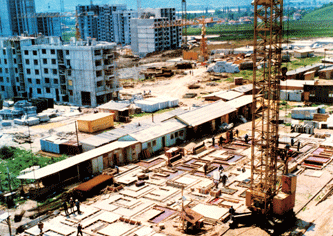
Permanent plants use appropriate bridge cranes, concrete plants, common equipment for concrete deposition (poker vibrators, external vibrators, vibrating plates), reinforcing sections with adequate equipment for straightening, cutting and rebar and assembly shaping, steam boiler room for steam curing of freshly set in concrete elements, workshops for equipment maintenance and the laboratory for quality control of the concrete. Production at the polygon (open-air) enables various variants of section organisation depending on climate and other conditions; absolutely adequate to permanent plant in enclosed space; using tower cranes instead of the bridge ones; supply of concrete with transit mixers from concrete plants; protection from direct drying (instead of steam curing) of freshly set in concrete elements with plastic foils (if climate conditions allow). Plant capacity is the most significant factor for the application rationality of the IMS Building Technology. Experience shows that minimal investment expenses in specific equipment for the IMS Building Technology are obtained for sections with annual production of 20,000 to 50,000 square meters of building structures. In that case, annual production absolutely depreciates investments in the equipment, while the same equipment is valuable per several years’ production (8-10 years and more). Permanent plants are built, as well, for 100,000 m2 but those capacities require a complex organisation and building control and advanced training of human resources.
Quality control of building material and production process is necessary for element production and building stability and security during assemblage, erection and utilisation.
TRANSPORT
Transport of elements from the production plant to the site requires only common vehicles. The heaviest elements do not overpass 7 tones, and their dimensions enable the use of trucks in public traffic. Rational truck transportation radius is cca. 100 km, while in practice rationality of the boat transport is cca. 1,000 km. Elements can also be transported by railroad.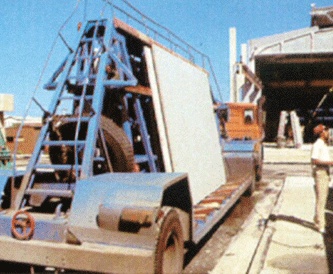
SKELETON ASSEMBLY
When building foundations are done, with precisely left openings for anchors of prefabricated columns, multi-storey columns are positioned and fixed, with the help of braces, in vertical position and controlled with geodetic surveying instruments (verticality and axis position). Temporary capitels already exists on columns on which floor structure elements are erected – floor slabs, edge beams and cantilever floor slabs. Afterwards, floor slabs are made monolith with web post-tensioning using appropriate short cables. Joints between columns and floor slabs are filled in with adequate mortar and, after its hardening, the entire floor plane is post-tensioned with cables into two orthogonal directions. After this action, braces fixing columns are released, supporting capitels are transported to another storey level and the operation of floor slabs erection is repeated.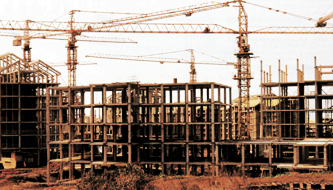
Appropriate available cranes or autoelevators are used for construction, in number and yield depending on building size and location. A well-organized group of 5 to 6 workers and a crane-operator can weekly complete a storey level of about 600 – 1,000 sq. m, depending of the architectural building design and the site conditions (approach possibilities of the crane to the building, jagged building plan). Complementary elements of the building, facade, partitions, utility works, can be positioned on the assembled structure while the assembly of upper levels is still in progress, shortening the building process and enabling great organisation and flexibility of building construction.
Defining of production and assembly process, with adequate norms, enables building control adapted to local conditions, so that appropriate building dynamic is realised and work dead line is reached in time. The IMS Building Technology transfer comprises local labour training for all those processes, with temporary supervision by the IMS Institute experts.
BASIC IMS SYSTEM ELEMENTS
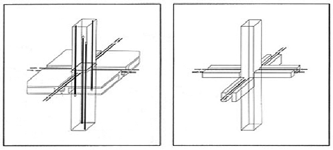
Columns, continual through maximum 3 storeys (depends on their cross-sections and storey height or possibilities of the crane used for erection), possessing square cross-section – dimensions: 30 x 30 – 60 x 60 cm. 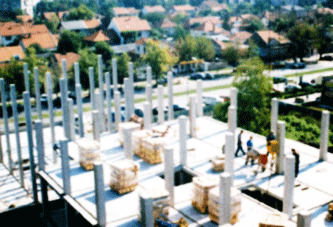
Floor slabs cover space between columns and can be manufactured with or without concrete ceiling, as one-piece (spans until 3.6 x 4.8 m) or multi-pieces aiming to adapt dimension for transportation and erection (ceilings made for the span 9.0 x 9.0 m are constructed from nine standard elements); the marginal girder and waffle web height is 20-40 cm (depending on column span between which space is covered), floor slab depth between coffer webs is 4-6 cm, and the ceiling one is 3 cm. 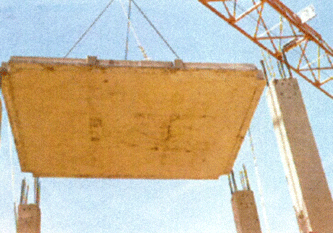
Cantilever floor slabs, which replace edge beams in architectural solutions where balconies, loggias or other housing space out of column span are required and which are connected only to two columns (as a cantilever) and their height and length correspond to floor slabs near which they are erected, while their maximal width is limited on 1/3 of the longitudinal span. They are waffled and can be with or without concrete ceiling. 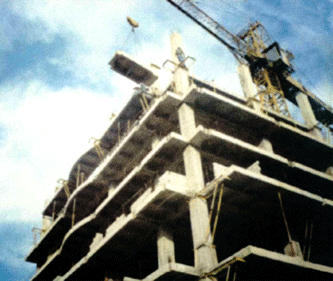
Edge girders have a boundary position in order to form frame beams and facade construction. Their lengths and depth are the same as at corresponding floor slabs with which they form a frame beam and their width is chosen according to architectural requirements for the adequate type of facade walls.
Stiffening walls are reinforced concrete panels (minimal depth – 15 cm), which stiffen the frame. They are positioned, by the rule, in the axis of two adjacent columns, having a function to form, together with columns, a structural element from foundations to the roof, ready to receive required intensity horizontal forces (in practice, those elements are often set in concrete in situ, especially at larger spans for the reasons of huge dimension, weight and slow frame erection).
Elevator manholes – in practice those elements are set in concrete in situ, because of non-rational series (small number of elements in constructing building in relation with the mould price for manufacturing within the own section), which, by the rule serve for the acceptance of horizontal forces together with stiffening walls.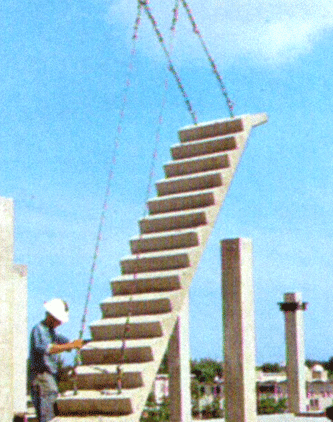
Stair elements for one-flight, double-flight or triple-flight stairs, with monolith or prefabricated steps.
DOWNLOAD THE BROCHURE PDF
English (0.8 MB)Spanish (0.8 MB)
Serbian (0.8 MB)
ONLY TEXT
•IMS Building Technology in practice








 COUNTRY OF ORIGIN
COUNTRY OF ORIGIN